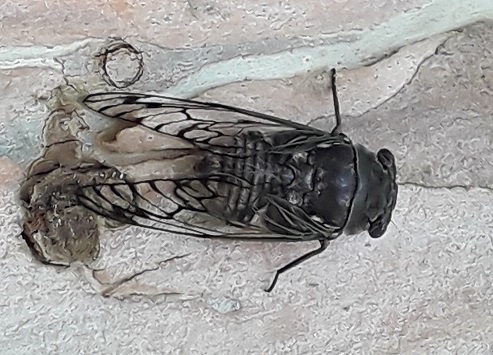One of the most common sounds across Paraguay during summer time is that of the cicadas. Their appearance every year heralds the arrival of summer.
Cicadas are large insects with large blunt heads and transparent wings. A pair of large eyes stare out from their heads and strong legs grip onto trees. Their wings are not put away under covers, such as beetles do. Rather they are folded upon their back.
Cicadas spend the majority of their time motionless on trees. They as however when need arises swift flyers.
Across the world there are many different species of cicada. The known and described species exceed 3000. Each with their own habitat and characteristics.
Broadly speaking cicadas fall into two categories. Periodic cicadas and annual cicadas. All cicadas spend the majority of their lives as larvae below ground. The two categories reflect differences in how the emerge from the ground and into their final airborne form.
Periodic cicadas emerge en mass after a set number of years whereas annual cicadas emerge regularly every year.
The most famous and well known of the cicada species are a number of the periodic ones. Such as the 13 year and 17 year cicadas.
The cicadas native to Paraguay are however annual ones. They appear year after year without fail.
Whilst underground as larvae cicadas feed on sap drawn from tree roots. Accordingly when then emerge it is normally close to a tree.
The insect prior to its final molt burrows up through the earth. On reaching the surface they leave behind circular holes about a centimetre across leading back down to where they had lived as larvae.
From there they make their way across the ground and up the nearest tree. Or nearest vertical object they encounter. Then once they have climbed far enough away from the ground they secure themselves firmly with their legs to make one final molt.
It takes a while to pull out of this skin, which splits down the back. Once they have done so they can become a free flying insect ready to go in search of a mate.
The majority of cicadas emerge under the cover of darkness. When there a less predators around to attack as the final molt is made. In the morning the number of cicadas that have emerged is shown by the number of empty shell cases still fixed to trees.
Once they have gone through their final molt the cicadas search for mates. This is the reason for the call they emit. Made by the males to attract females.
The sound produced by a cicada is a very loud one. Almost deafening at close quarters and clearly audible at a great distance. It is made by rubbing body membranes together and is a continuous buzzing sound. Very distinctive and easily identified.
I have living in the trees around my house two different species of cicada. I know this to be the case from looking at the shell cases they leave behind as the molt.
They are both about the same size. One has shell cases that are of a reddish brown. Those are the most common. There are though to be found other shell cases that are of a much lighter sandy colour. Once they become free flying cicadas I cannot tell which was which.
Then as summer continues more cicadas emerge every night and fill the air with their calls until summer begins to wain. Then as they disappear once more the air seem strangely silent.


This year, in my neck of the woods, we had cicadas around August if I recall correctly. It was an unusual event and only lasted a few days. Maybe they were some periodic species?
Yes that does sound very early. But this year the weather has been unusual and with 3000 different species there must be ones with all sorts of timings and habits
Howdy! I just want to give you a huge thumbs up for your excellent info you have got here on this post. I am returning to your blog for more soon. Berte Steven Faucher